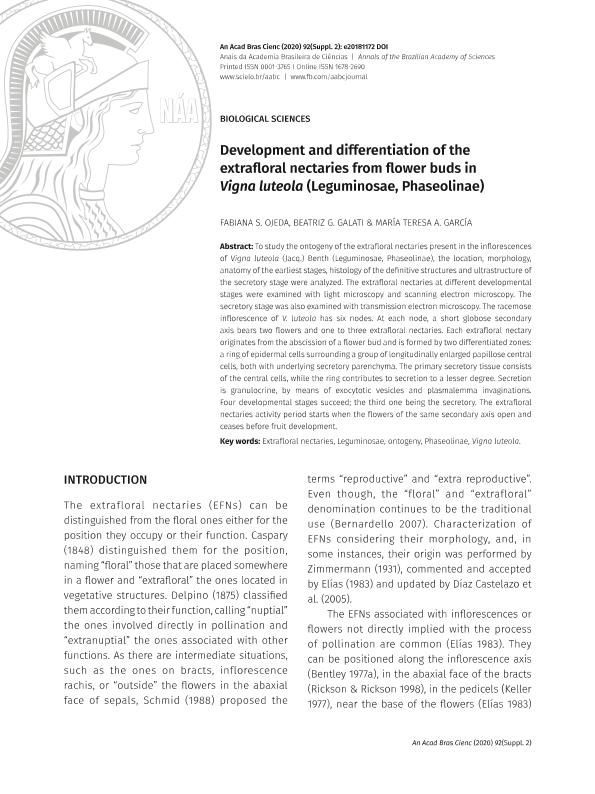Artículo
Development and differentiation of the extrafloral nectaries from flower buds in Vigna luteola (Leguminosae, Phaseolinae)
Fecha de publicación:
10/2020
Editorial:
Academia Brasileira de Ciencias
Revista:
Anais da Academia Brasileira de Ciencias
ISSN:
0001-3765
e-ISSN:
1678-2690
Idioma:
Inglés
Tipo de recurso:
Artículo publicado
Clasificación temática:
Resumen
To study the ontogeny of the extrafloral nectaries present in the inflorescences of Vigna luteola (Jacq.) Benth (Leguminosae, Phaseolinae), the location, morphology, anatomy of the earliest stages, histology of the definitive structures and ultrastructure of the secretory stage were analyzed. The extrafloral nectaries at different developmental stages were examined with light microscopy and scanning electron microscopy. The secretory stage was also examined with transmission electron microscopy. The racemose inflorescence of V. luteola has six nodes. At each node, a short globose secondary axis bears two flowers and one to three extrafloral nectaries. Each extrafloral nectary originates from the abscission of a flower bud and is formed by two differentiated zones: a ring of epidermal cells surrounding a group of longitudinally enlarged papillose central cells, both with underlying secretory parenchyma. The primary secretory tissue consists of the central cells, while the ring contributes to secretion to a lesser degree. Secretion is granulocrine, by means of exocytotic vesicles and plasmalemma invaginations. Four developmental stages succeed; the third one being the secretory. The extrafloral nectaries activity period starts when the flowers of the same secondary axis open and ceases before fruit development.
Palabras clave:
EXTRAFLORAL NECTARIES
,
LEGUMINOSAE
,
ONTOGENY
,
PHASEOLINAE
,
VIGNA LUTEOLA
Archivos asociados
Licencia
Identificadores
Colecciones
Articulos(INMIBO (EX - PROPLAME))
Articulos de INSTITUTO DE MICOLOGIA Y BOTANICA
Articulos de INSTITUTO DE MICOLOGIA Y BOTANICA
Citación
Ojeda, Fabiana Soledad; Galati, Beatriz Gloria; Amela Garcia, Maria Teresa; Development and differentiation of the extrafloral nectaries from flower buds in Vigna luteola (Leguminosae, Phaseolinae); Academia Brasileira de Ciencias; Anais da Academia Brasileira de Ciencias; 92; 10-2020; 1-10
Compartir
Altmétricas




